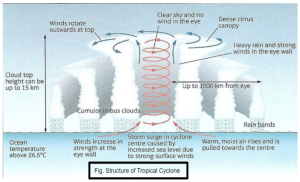Context: According to a study published in the journal Nature Communications, a combination of global warming and a cyclical event called the Pacific Decadal Oscillation (PDO) could make tropical cyclones more frequent in the coming years.
More on News
- The number of such tropical cyclones was 43% fewer in 1981-2010 compared with 1951-1980 as the PDO was in a warmer or positive phase.
- An El Nino is currently developing in the Pacific which has recorded rainfall deficits of 7% and 17% in central and southern India respectively.
- El Nino-Southern Oscillation (ENSO) with a positive PDO is generally not good, but when linked with a negative PDO, brings more rain to India.
Cyclone
- ENSO: El Nino conditions lead to increased vertical wind shear over the Atlantic basin and conversely, La Nina conditions are generally associated with lower wind shear, promoting more favorable conditions for tropical cyclone formation and intensification.
- PDO: It is a long-term climate pattern that influences sea surface temperatures and atmospheric conditions in the North Pacific Ocean.
- It operates on a longer timescale than ENSO, typically spanning decades.
- Rapid Intensification (RI): It refers to the phenomenon where a tropical cyclone experiences a significant increase in its maximum sustained winds (by around 35 knots) over a relatively short period of time.
- Vertical Wind Shear: This refers to the change in wind speed and direction with height in the atmosphere.
- High vertical wind shear can inhibit the development and intensification of tropical cyclones.
|
- Cyclone: A cyclone is a large air mass that rotates around a strong center of low atmospheric pressure, counterclockwise in the Northern Hemisphere and clockwise in the Southern Hemisphere as viewed from above.
- Tropical cyclones are intense low-pressure areas confined to the area lying between 30° N and 30° S latitudes in the atmosphere.
- Some conditions for the emergence of a tropical cyclone are:
- Large and continuous supply of warm and moist air.
- Strong Coriolis force that can prevent the filling of low pressure at the centre.
- Unstable condition that creates local disturbances.
- Absence of strong vertical wind wedge which disturbs the vertical transport of latent heat.
How Cyclones are formed

- Formation and Initial Development Stage
- A warm sea with abundant and turbulent transfer of water vapor.
- Atmospheric instability·
- Mature Phase
- Air rises and tends to spread out at the tropopause level.
- Air warms up by compression and a warm ‘Eye’ is generated.
- Modification and Decay
- Cyclone begins to weaken as its source of warm moist air begins to ebb, or is abruptly cut off.
Reasons for Increasing the Frequency and Intensity of Tropical Cyclone
- Climate Change: Rising sea surface temperatures provide more energy to fuel cyclones, allowing them to intensify more quickly and become more powerful.
- For example, cyclone Mocha over Bay of Bengal.
- Warmer Ocean Waters: As global temperatures rise, the Indian Ocean is warming, providing more heat and moisture to fuel cyclone development and intensification.
- For example, increasing sea surface temperature over Arabian Sea is providing ample supply of energy to intensify cyclones, for example, Cyclone Tauktae.
- Sea Level Rise: Higher Sea levels mean that storm surges can penetrate farther inland, causing more extensive coastal flooding and damage.
- For instance, Hurricanes are causing more intense rainfall and have increased coastal flooding.
- Changing Wind Patterns: Changes in atmospheric circulation patterns can steer cyclones towards more vulnerable areas and also contribute to their intensification.
| Cyclones |
Description |
| Biparjoy |
Time: June 2023
Origin: Arabian Sea
Landfall: Gujarat |
| Mandous |
Time: December 2022
Origin:
Landfall: Andaman and Nicobar Island and Tamil Nadu |
| Sitrang |
Time: October 2022
Origin: Bay of Bengal
Landfall: Odisha, West Bengal, Assam and A&N Islands |
| Asani |
Time: May 2022
Origin: Bay of Bengal
Landfall: Andhra Pradesh, Tamil Nadu, Karnataka and Odisha |
| Tauktae |
Time: May 2021
Origin: Arabian Sea
Landfall: Gujarat, Maharashtra and Karnataka |
| Yaas |
Time: May 2021
Origin: Bay of Bengal
Landfall: Odisha, Jharkhand, and Bihar |
| Nisarga |
Origin: Arabian Sea
Landfall: Maharashtra |
- Ocean Heat Content: Increased heat content can result in stronger cyclones. For example, ocean heat content anomaly has led to an intensification of the Kyarr cyclone and Ockhi cyclone.
- Monsoon Variability: The Indian Ocean Dipole and El Niño-Southern Oscillation (ENSO) can affect monsoon patterns, which in turn can influence cyclone development.
Disaster Management
- Pre-Disaster Preparation:
- Early Warning Systems: These systems can help communities prepare and evacuate in advance, reducing the loss of lives.
- Disaster Preparedness: Educate communities about cyclone risks, preparedness measures, and evacuation procedures along with holding regular drills.
- Response During Disaster:
- Activation of Emergency Operations Centers.
- Evacuation Planning and Execution: Specially for areas prone to flooding, storm surges, and landslides.
- Search and Rescue Operations: Trained search and rescue teams, including local emergency responders, like Aapda Mitras.
- Post Disaster
- Medical Assistance: To treat injuries, provide medical care, and prevent the outbreak of diseases.
- Distribution of Aid: Food, water, clothing, hygiene kits, and other essential supplies are distributed to affected communities. Humanitarian agencies and NGOs also play crucial role in this stage.
- Psychosocial Support: To help victims better deal with trauma and stress.
- Recovery and Capacity Building
- Resilient Infrastructure: This includes constructing cyclone-resistant buildings, reinforcing critical infrastructure, etc.
- Climate-Resilient Agriculture: Agricultural practices that can withstand heavy rainfall, waterlogging, and flooding.
- Community-Based Adaptation: The traditional knowledge and practices can contribute to effective resilience-building efforts.
Conclusion
- It’s important to recognize that addressing cyclone impacts is not a one-size-fits-all approach.
- A combination of short-term disaster response and long-term climate adaptation measures is essential for creating a more resilient future in the face of increasing cyclone intensity.
News Source: The Hindu
To get PDF version, Please click on "Print PDF" button.

